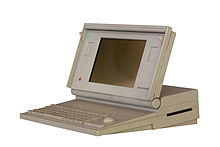This article has multiple issues. Please help improve it or discuss these issues on the talk page. (Learn how and when to remove these messages)
|
 | |
| Manufacturer | Apple Computer, Inc. |
|---|---|
| Type | Portable computer |
| Release date | September 20, 1989 |
| Introductory price | (with hard drive) US$7,300 (equivalent to $17,900 in 2023) |
| Discontinued | October 21, 1991 |
| Operating system | System 6.0.4 - 7.5.5 |
| CPU | Motorola 68000 @ 16 MHz |
| Memory | 1 MB SRAM (expandable to 9 MB), 256 KB ROM |
| Storage | 1.44 MB double-sided floppy drive, 40 MB 3.5″ Conner hard drive |
| Display | 9.8″ black and white active matrix LCD screen |
| Graphics | 640 × 400 pixel, 1-bit |
| Input | keyboard, trackball |
| Power | 6V 5Ahr lead-acid battery pack, AC Charger |
| Dimensions | 4.05″ × 15.25″ × 14.43″ |
| Mass | 16 lb (7.3 kg) |
| Predecessor | Macintosh Plus (Macintosh SE) |
| Successor | PowerBook 100 PowerBook 140/170 |
The Macintosh Portable is a portable computer that was designed, manufactured, and sold by Apple Computer, Inc. from September 1989 to October 1991. It is the first battery-powered Macintosh, which garnered significant excitement from critics, but sales to customers were quite low. It featured a fast, sharp, and expensive monochrome active matrix LCD screen in a hinged design that covered the keyboard when the machine was not in use. The Portable was one of the early consumer laptops to employ an active matrix panel—only the most expensive of the initial PowerBook line, the PowerBook 170, had such a panel. The machine was designed to deliver high performance, at the cost of increased price and weight. The Portable was discontinued in October 1991.
The Portable has features similar to the Atari STacy, a version of their Atari ST computer which contained a built in keyboard and monitor. Macintosh Portable can run Macintosh System 6.0.4 through System 7.5.5.[citation needed]